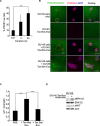Molecular profiling of prostate cancer derived exosomes may reveal a predictive signature for response to docetaxel
- PMID: 25844599
- PMCID: PMC4673300
- DOI: 10.18632/oncotarget.3226
Molecular profiling of prostate cancer derived exosomes may reveal a predictive signature for response to docetaxel
Abstract
Docetaxel is a cornerstone treatment for metastatic, castration resistant prostate cancer (CRPC) which remains a leading cause of cancer-related deaths, worldwide. The clinical usage of docetaxel has resulted in modest gains in survival, primarily due to the development of resistance. There are currently no clinical biomarkers available that predict whether a CRPC patient will respond or acquire resistance to this therapy. Comparative proteomics analysis of exosomes secreted from DU145 prostate cancer cells that are sensitive (DU145 Tax-Sen) or have acquired resistance (DU145 Tax-Res) to docetaxel, demonstrated significant differences in the amount of exosomes secreted and in their molecular composition. A panel of proteins was identified by proteomics to be differentially enriched in DU145 Tax-Res compared to DU145 Tax-Sen exosomes and was validated by western blotting. Importantly, we identified MDR-1, MDR-3, Endophilin-A2 and PABP4 that were enriched only in DU145 Tax-Res exosomes. We validated the presence of these proteins in the serum of a small cohort of patients. DU145 cells that have uptaken DU145 Tax-Res exosomes show properties of increased matrix degradation. In summary, exosomes derived from DU145 Tax-Res cells may be a valuable source of biomarkers for response to therapy.
Keywords: biomarkers; docetaxel; exosomes; prostate cancer; resistance.
Conflict of interest statement
The authors declare no conflict of interest.
Figures






References
-
- Tannock IF, de Wit R, Berry WR, Horti J, Pluzanska A, Chi KN, Oudard S, Theodore C, James ND, Turesson I, Rosenthal MA, Eisenberger MA, Investigators TAX Docetaxel plus prednisone or mitoxantrone plus prednisone for advanced prostate cancer. The New England journal of medicine. 2004;351:1502–1512. - PubMed
-
- Berthold DR, Pond GR, Soban F, de Wit R, Eisenberger M, Tannock IF. Docetaxel plus prednisone or mitoxantrone plus prednisone for advanced prostate cancer: updated survival in the TAX 327 study. Journal of clinical oncology: official journal of the American Society of Clinical Oncology. 2008;26:242–245. - PubMed
-
- Kavallaris M. Microtubules and resistance to tubulin-binding agents. Nature reviews Cancer. 2010;10:194–204. - PubMed
-
- Seruga B, Ocana A, Tannock IF. Drug resistance in metastatic castration-resistant prostate cancer. Nature reviews Clinical oncology. 2011;8:12–23. - PubMed
Publication types
MeSH terms
Substances
LinkOut - more resources
Full Text Sources
Other Literature Sources
Medical
Molecular Biology Databases

